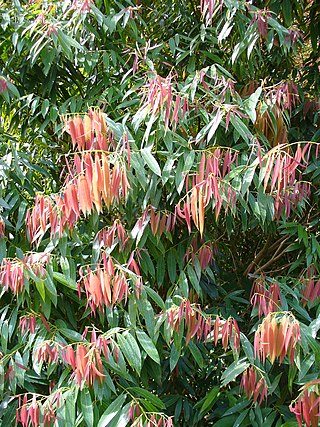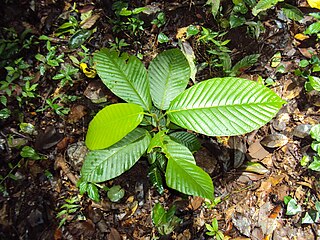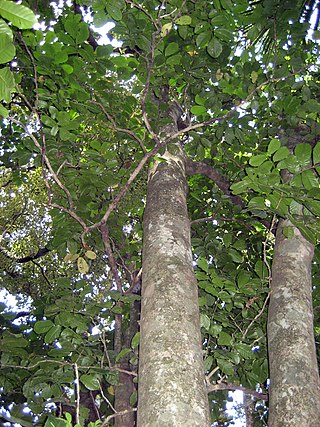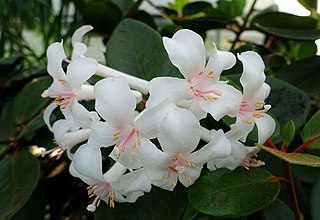
Mesua is a genus of flowering plants in the family Calophyllaceae, native to tropical southern Asia. Common names include ironwood and rose chestnut.

Dipterocarpus is a genus of flowering plants and the type genus of family Dipterocarpaceae.

Dysoxylum is a flowering plant genus of trees and shrubs from the mahogany family, Meliaceae.
Dipterocarpus acutangulus is a species of tree in the family Dipterocarpaceae. The species name acutangulus is derived from Latin and refers to the ribs of the fruit calyx tube. It is native to peninsular Thailand and Malaysia and also Borneo, where it is locally known as keruing merkah or keruing beludu. It is an emergent tree up to 60 m tall. The tree occurs in mixed dipterocarp forests found on sandy and sandy clay soils on coastal hills and inland ridges, up to 1000 m elevation. It occurs in at least one protected area.

Dipterocarpus gracilis is a critically endangered species of tree in the family Dipterocarpaceae, native to South Asia and Southeast Asia.
Dipterocarpus hasseltii is a species of tree in the family Dipterocarpaceae. This large tree occurs in lowland dipterocarp forest and is cut for keruing timber. It is found in Indonesia, Peninsular Malaysia, Sabah, the Philippines, Thailand and Vietnam.
Dipterocarpus kerrii is a species of tree in the family Dipterocarpaceae, native to the Andaman Islands, Sumatra, Borneo, Peninsular Malaysia, Laos, Myanmar, the Philippines, Singapore, Thailand and Vietnam.

Chionanthus, common name: fringetrees, is a genus of about 150 species of flowering plants in the family Oleaceae.

Dipterocarpus grandiflorus is a species of flowering plant in the Dipterocarpaceae family. It is an endangered medium hardwood tree of Southeast Asia. It is a large tree which can grow up to 50 metres tall.

Anisoptera costata is an endangered species of plant in the family Dipterocarpaceae. The specific epithet costata means "ribbed", referring to the prominent venation of the leaf blade. A huge emergent tree up to 65 m high, it is found in evergreen and semi-evergreen lowland tropical seasonal forests of Indo-Burma and in mixed dipterocarp forests of Malesia.

Hopea beccariana is a species of tree in the family Dipterocarpaceae. It is named for the Italian botanist Odoardo Beccari.

Anisoptera is a genus of plants in the family Dipterocarpaceae. It contains ten species distributed from Chittagong in southeast of Bangladesh to New Guinea.
Dryobalanops oblongifolia is a species of plant in the family Dipterocarpaceae, native to regions of Southeast Asia and Maritime Southeast Asia.

Dipterocarpus alatus, also known colloquially as the resin tree, is a tropical forest tree, of dense evergreen or mixed dense forests, in tropical Asia. It is considered vulnerable.
Dipterocarpus dyeri (Khmer: rôyiëng, chhë tiël pruhs, chhë tiël th'nô:r, local name Kompong Thom: chhieutiel chgor, name used for commercial timber and the group of trees harvested for such: keruing, Vietnamese: Dầu Song Nàng, is a species of tree in the family Dipterocarpaceae found in Myanmar, Thailand, Peninsular Malaysia, Cambodia, Vietnam, and northwestern Borneo. The tree is found in rain forest and lowland semi-evergreen dipterocarp forests, an alternative habitat description is mixed dense forests of the plains, mainly among rivers and valleys. The tree is a climax or late successional species, which in some secondary forests forms relatively young pure colonies. The conservation status is based on rates of habitat loss, the major threat to the taxa, though in Vietnam it is cited as having a less threatened conservation status of Vulnerable.
Dipterocarpus kunstleri grows as a canopy tree up to 40 metres (130 ft) tall, with a trunk diameter of up to 1 metre. Bark is orange-brown. Fruit is ellipsoid, up to 5 centimetres (2.0 in) long. Habitat is mixed dipterocarp forest from sea-level to 400 metres (1,300 ft) elevation. D. kunstleri is found in Sumatra, Peninsular Malaysia, Borneo and the Philippines.
Dipterocarpus lowii is a tree in the family Dipterocarpaceae.
Dipterocarpus sublamellatus grows as a large tree up to 70 metres (230 ft) tall, with a trunk diameter of up to 3 metres (10 ft). Bark is orange-brown. The fruits are round, up to 3 cm (1 in) in diameter. It is found in a variety of now vulnerable habitats from sea-level to 400 metres (1,300 ft) elevation. D. sublamellatus is native to Sumatra, Peninsular Malaysia and Borneo.

Gaultheria fragrantissima is a species of flowering plant native to southern and southeastern Asia. It is commonly known as fragrant wintergreen or dhasingre.

Rhododendron jasminiflorum is a rhododendron species native to Peninsular Malaysia, Borneo, Sumatra, and the Philippines.












